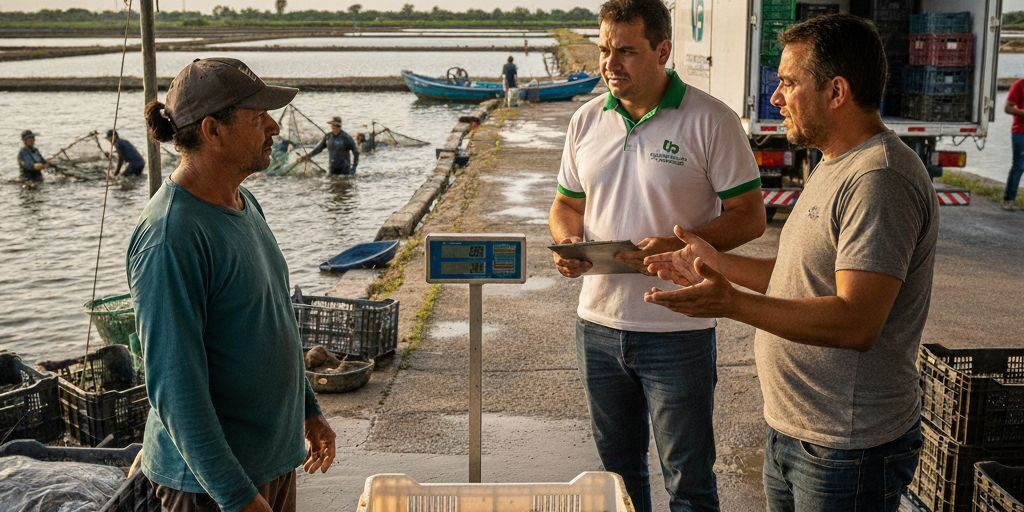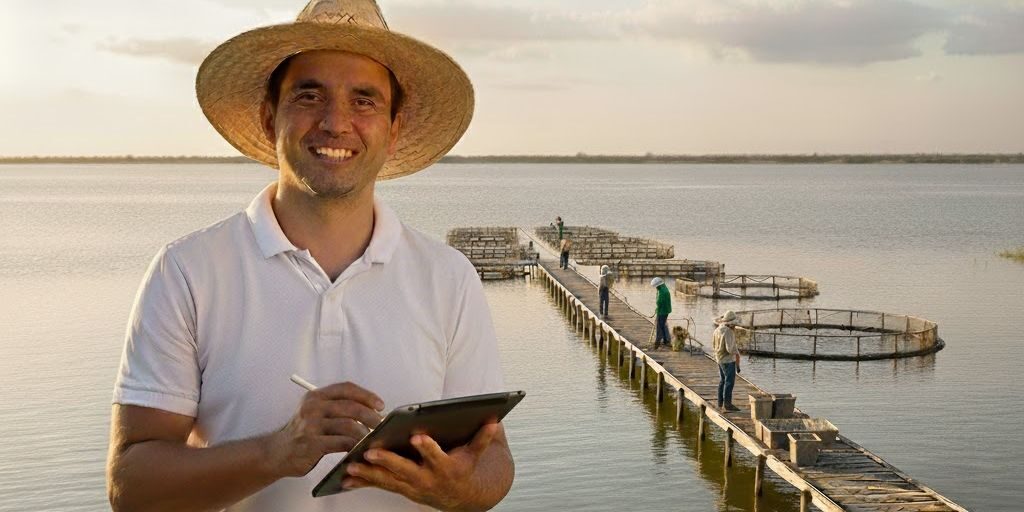- Software Gestor para Aquicultura
- (85) 2139-6730
- contato@despesca.com.br
How to Negotiate the Best Price at Harvest: Processors vs. Middlemen

Cooperativism in Aquaculture
23/09/2025
Water Grant: Ensure the Legal Right to Use Water for Your Aquaculture Production in Brazil
25/09/2025The harvest represents the culmination of months of hard work and investment. Consequently, the moment of sale is one of the most decisive for the financial health of an aquaculture farm. The ability to negotiate the best price can mean the difference between a profitable cycle and a merely satisfactory result. In the market, two main sales channels stand out: processing plants (processors) and middlemen. Each has distinct characteristics that the farmer needs to understand to make the most strategic decision.
This article has been prepared to analyze the pros and cons of each type of buyer and, above all, to provide tools that strengthen your position at the negotiating table.
Analyzing the Buyers: Processing Plants
Processing plants are generally larger companies with infrastructure for large-scale processing, storage, and distribution. Negotiations with them tend to be more formalized.
Pros:
- Purchase Volume: They have the capacity to absorb large production volumes, which is ideal for larger-scale farms.
- Predictability: Many work with supply contracts, offering greater security and revenue predictability for the farmer.
- Quality Requirements: Although a challenge, meeting their sanitary and standardization requirements can add value to the product and open doors to more demanding markets, such as exports.
Cons:
- Less Price Flexibility: Due to their cost structure and large-scale operations, the prices offered may be less attractive compared to one-off negotiations.
- Payment Terms: Payment terms are often longer, requiring a well-structured cash flow from the farmer.
- Bureaucracy: The registration and sales process usually involves more documentation and formalities, such as invoices and certifications.
Analyzing the Buyers: Middlemen
The middleman, in turn, is an intermediary who buys directly from the farmer to resell to fish markets, restaurants, or other smaller processors. The business relationship is often more personal and direct.
Pros:
- Agility in Negotiation: The sales process is fast and with less bureaucracy.
- Quick Payment: One of their biggest advantages is liquidity, with payments made on the spot or in very short terms.
- Flexibility: There may be more room to negotiate smaller volumes or non-standardized batches.
Cons:
- Price Volatility: Prices can fluctuate dramatically according to momentary supply and demand, making revenue less predictable.
- Informality: The lack of formal contracts can leave the farmer unprotected in case of commercial disagreements.
- Lower Purchase Capacity: They generally do not have the structure to purchase the entire production of a large harvest at once.
Fundamental Strategies to Negotiate the Best Price
Regardless of the chosen buyer, the success of the negotiation depends on the farmer’s preparation. Therefore, some actions are fundamental.
First and foremost, know your costs in detail. It is impossible to negotiate a fair price without knowing exactly what your production cost per kilogram is. This number is your baseline, your starting point. Without it, any negotiation is a shot in the dark.
Secondly, monitor the market. Keep track of the prices practiced in your region for the different classifications of your product. This information allows you to assess whether the offer received is fair and competitive.
Furthermore, quality is your greatest asset. A well-graded product, with good appearance, uniform weight, and undeniable freshness, has much greater bargaining power. Records of biometrics and the health of the stock can be used as solid arguments during the sale.
Finally, plan the harvest. Whenever possible, align your harvest date with periods of higher market demand, such as holidays or commemorative dates, to take advantage of seasonally higher prices.
Technology as an Ally in Negotiation
Knowing how to negotiate the best price is not just a matter of interpersonal skill; it is, above all, a matter of information. This is where management technology becomes indispensable.
Using management software, such as Despesca, transforms how a farmer prepares for a sale. The system allows for precise control over all costs involved in the production cycle, from post-larvae and feed to labor and energy. With this, the production cost calculation ceases to be an estimate and becomes an exact and reliable figure.
Additionally, Despesca organizes the history of biometrics, survival rates, and feed conversion, generating detailed reports on the quality and performance of the stock. Presenting this data to the buyer demonstrates professionalism and transparency, justifying a higher price for the proven quality of the product.
In conclusion, the decision between selling to processing plants or middlemen will depend on the scale of your production, your cash flow needs, and your management profile. However, the most powerful tool in any scenario is information. A well-informed farmer, who knows their costs and the quality of their product, does not just sell: they negotiate, position themselves, and maximize the profitability of their business.




